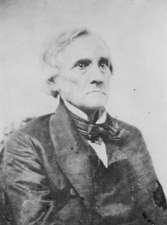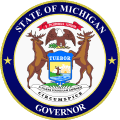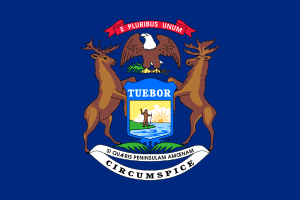William Woodbridge
| William Woodbridge | |
|---|---|
 | |
| United States Senator from Michigan | |
|
In office March 4, 1841 – March 4, 1847 | |
| Preceded by | John Norvell |
| Succeeded by | Alpheus Felch |
| 2nd Governor of Michigan | |
|
In office January 7, 1840 – February 23, 1841 | |
| Lieutenant | J. Wright Gordon |
| Preceded by | Stevens T. Mason |
| Succeeded by | J. Wright Gordon |
| Delegate to the U.S. House of Representatives from Michigan Territory's at-large congressional district | |
|
In office March 4, 1819 – August 9, 1820 | |
| Preceded by | none |
| Succeeded by | Solomon Sibley |
| 3rd Secretary of Michigan Territory | |
|
In office October 15, 1814 – January 15, 1828 | |
| President | James Madison |
| Preceded by | Reuben Atwater |
| Succeeded by | James Witherell |
| Member of the Ohio House of Representatives | |
|
In office 1807–1808 | |
| Member of the Ohio Senate | |
|
In office 1809–1814 | |
| Member of the Michigan Senate | |
|
In office 1838–1839 | |
| Personal details | |
| Born |
August 20, 1780 Norwich, Connecticut |
| Died |
October 20, 1861 (aged 81) Detroit, Michigan |
| Political party | Whig |
| Spouse(s) | Juliana Trumbull |
| Religion | Congregationalist |
William Woodbridge (August 20, 1780 – October 20, 1861) was a U.S. statesman in the states of Ohio and Michigan and in the Michigan Territory prior to statehood. He served as the second Governor of Michigan and a United States Senator from Michigan.
Early life in Connecticut and politics in Ohio
Woodbridge was born in Norwich, Connecticut, and as a child moved with his family to Marietta, Ohio in about 1790. He began the study of law in Marietta and developed a close friendship with Lewis Cass. He returned to Connecticut to complete his law studies and, after returning to Ohio, was admitted to the Ohio bar in 1806 where he began a practice in Marietta, Ohio. In June 1806, he married Juliana Trumbull, the daughter of John Trumbull.
He was a member of the Ohio House of Representatives in 1807, and was elected to the Ohio Senate in 1808, serving from 1809 to 1814. He was also the prosecuting attorney for New London (now Washington County, Ohio) from 1808 to 1814.
Politics in Michigan Territory
In 1814, Woodbridge's old friend Lewis Cass, who had become Governor of the Michigan Territory, encouraged him to accept appointments as Secretary of the Territory and as the collector of customs at the Port of Detroit. On October 15, 1814, Woodbridge reluctantly accepted the appointments from President James Madison and moved to Detroit, Michigan. During the frequent absences of Cass, Woodbridge served as acting Governor. In 1817 became a trustee of the University of Michigan.
Under the rules of Territorial government, the Territory did not have representation in the U.S. Congress. Woodbridge influenced Congress to pass legislation authorizing the selection of a non-voting Delegate to Congress. Woodbridge became Michigan Territory's first Delegate, serving in the 16th Congress from March 4, 1819, to his resignation on August 9, 1820 due to illness in his family. Solomon Sibley succeeded Woodbridge as Delegate. He remained the Territorial Secretary while Delegate.
As a Delegate, Woodbridge worked for the passage of legislation that recognized old French land titles in the Territory according to the terms of the previously signed treaties. He also secured approval for the construction of government roads from the Great Miami River to Detroit, and from Detroit to Chicago. He was also a strong advocate for Michigan's claim to the Toledo Strip, which was disputed with the state of Ohio.
In 1828, he was appointed one of three Territorial Supreme Court judges by President John Quincy Adams, succeeding James Witherell and serving in this capacity until 1832 when his term expired and President Andrew Jackson chose a replacement who was not from the Whig party as Woodbridge was.
Politics and Governorship in the State of Michigan
Woodbridge was a delegate to the State constitutional convention in 1835 and a member of the Michigan State Senate, 1838–1839. He was elected as the second Governor of Michigan in 1840, leading the Whig party to sweeping statewide victories under the slogan "Woodbridge and reform" (along with William Henry Harrison's national campaign). He resigned as Governor on February 23, 1841 to take a seat in the United States Senate and was succeeded by his Lieutenant Governor, J. Wright Gordon.
Woodbridge was elected to the Senate by the Michigan Legislature and served from March 4, 1841, to March 4, 1847. He was only one of two Whig Senators who represented Michigan, alongside Augustus S. Porter whom he served with for most of his term. Woodbridge served as chairman of the Committee on Public Lands in the 28th Congress, 1843–1844, and of the Committee on Patents and the Patent Office in the 29th Congress, 1845–1846. He did not seek reelection.
Retirement and death
After leaving the Senate, he retired from public life and devoted his time to horticulture. He died in Detroit and is interred there in Elmwood Cemetery.
Woodbridge Township, Michigan in Hillsdale County, Michigan is named for him. The Woodbridge Historic District and Woodbridge Avenue in Detroit are also named for him.
References
- United States Congress. "William Woodbridge (id: W000709)". Biographical Directory of the United States Congress.
- Benjamin Harrison and Governor Woodbridge
- "s.v. Hon. William Woodbridge". Cyclopedia of Michigan. Ann Arbor, Mich.: University of Michigan Library. 2005 [1900]. pp. 162–163. Retrieved 2007-03-24.
- Political Graveyard
- Find a Grave
- memorial library
| Political offices | ||
|---|---|---|
| Preceded by Reuben Atwater |
Secretary of Michigan Territory October 15, 1814 – January 15, 1828 |
Succeeded by James Witherell |
| Preceded by Stevens T. Mason |
Governor of Michigan 1840–1841 |
Succeeded by J. Wright Gordon |
| Ohio House of Representatives | ||
| New district | Representative from Washington and Athens Counties 1808–1809 Served alongside: Leonard Jewett |
Succeeded by Simeon Pool William R. Putnam |
| Ohio Senate | ||
| Preceded by Leonard Jewett |
Senator from Washington and Athens Counties 1811–1814 |
Succeeded by William R. Putnam |
| United States House of Representatives | ||
| Preceded by New seat |
Delegate to the U.S. House of Representatives from Michigan Territory March 4, 1819 – August 9, 1820 |
Succeeded by Solomon Sibley |
| United States Senate | ||
| Preceded by John Norvell |
U.S. Senator (Class 2) from Michigan 1841–1847 Served alongside: Augustus S. Porter, Lewis Cass |
Succeeded by Alpheus Felch |



